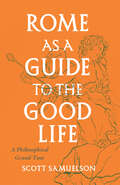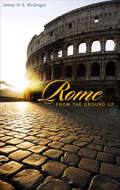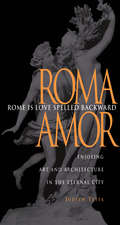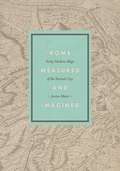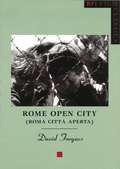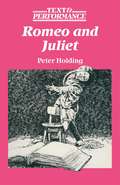- Table View
- List View
Rome: The Shaping of Three Capitals (Routledge Revivals)
by Paul BalchinFirst published in 2017, Rome: The Shaping of Three Capitals explores the impact of political history on the built environment of the Eternal City. The book divides Rome’s history into three main periods: the rulership of the early kings from the 8th to the 6th centuries BC; the period of Etruscan culture and architecture up to the end of the Roman Empire in 5th century AD; and, the 6th century to 1870, when Rome stood as the ecclesiastical capital of the Catholic Church and the temporal state of the Papal States. The final section of the book examines the Risorgimento, the unification of Italy, and the development of the fascist state; a time when Rome became the capital of Italy and endeavoured to establish a new empire. Exploring political instability and change, Balchin demonstrates the strong connection between politics and the physical shaping of the city through an examination of the successive styles of architecture, from Classical to Modernist.
Rome: The Shaping of Three Capitals (Routledge Revivals)
by Paul BalchinFirst published in 2017, Rome: The Shaping of Three Capitals explores the impact of political history on the built environment of the Eternal City. The book divides Rome’s history into three main periods: the rulership of the early kings from the 8th to the 6th centuries BC; the period of Etruscan culture and architecture up to the end of the Roman Empire in 5th century AD; and, the 6th century to 1870, when Rome stood as the ecclesiastical capital of the Catholic Church and the temporal state of the Papal States. The final section of the book examines the Risorgimento, the unification of Italy, and the development of the fascist state; a time when Rome became the capital of Italy and endeavoured to establish a new empire. Exploring political instability and change, Balchin demonstrates the strong connection between politics and the physical shaping of the city through an examination of the successive styles of architecture, from Classical to Modernist.
Rome (Oxford Archaeological Guides)
by Amanda ClaridgeThe city of Rome is the largest archaeological site in the world, capital and showcase of the Roman Empire and the centre of Christian Europe. This guide provides: · Coverage of all the important sites in the city from 800 BC to AD 600 and the start of the early middle ages, drawing on the latest discoveries and the best of recent scholarship · Over 220 high-quality maps, site plans, diagrams and photographs · Sites divided into fourteen main areas, with star ratings to help you plan and prioritize your visit: Roman Forum; Upper Via Sacra; Palatine; Imperial Forums; Campus Martius; Capitoline Hill; Circus Flaminius to Circus Maximus; Colosseum and Esquiline hill; Caelian hill and the inner via Appia; Lateran to Porta Maggiore; Viminal hill; Pyramid to Testaccio; the outer via Appia; other outlying sites; Museums and Catacombs. · Introduction offering essential background to the history and culture of ancient Rome, placing the city in the context of the development of the empire, highlighting the nature of Roman achievement, and explaining how Rome came to be the largest city in the ancient world. · Comprehensive glossaries of Rome's building materials, techniques and building types, a chronological table of kings, emperors, and the early popes, information about opening times, references and suggestions for further reading and a detailed user-friendly index. For this new edition the original text has been extensively revised, adding over 20 more sites and illustrations, the itineraries have been re-organized and expanded to suit the many changes that have taken place in the past decade, and the practical information and references have been fully updated.
Rome and China: Points of Contact
by Hyun Jin Kim Samuel N.C. Lieu Raoul McLaughlinRome and China provides an updated history and analysis of contacts and mutual influence between two of ancient Eurasia’s most prominent imperial powers, Rome and China. It highlights the extraordinary interconnectivity of ancient Eurasia which allowed for actual contacts between Rome and China (however fleeting) and examines in detail the influences from both ends of Eurasia which had cultural and political consequences for both Rome and China. This volume will be of interest to anyone working on the Roman Empire, Inner Asia, the Silk Routes and China in the Classical and Late Antique periods.
Rome and China: Points of Contact
by Hyun Jin Kim Samuel N.C. Lieu Raoul McLaughlinRome and China provides an updated history and analysis of contacts and mutual influence between two of ancient Eurasia’s most prominent imperial powers, Rome and China. It highlights the extraordinary interconnectivity of ancient Eurasia which allowed for actual contacts between Rome and China (however fleeting) and examines in detail the influences from both ends of Eurasia which had cultural and political consequences for both Rome and China. This volume will be of interest to anyone working on the Roman Empire, Inner Asia, the Silk Routes and China in the Classical and Late Antique periods.
Rome and Religion in the Medieval World: Studies in Honor of Thomas F.X. Noble (Church, Faith and Culture in the Medieval West)
by Valerie L. Garver Owen M. PhelanRome and Religion in the Medieval World provides a panoramic and interdisciplinary exploration of Rome and religious culture. The studies build upon or engage Thomas F.X. Noble’s interest in Rome, especially his landmark contributions to the origins of the Papal States and early medieval image controversies. Scholars from a variety of disciplines offer new viewpoints on key issues and questions relating to medieval religious, cultural and intellectual history. Each study explores different dimensions of Rome and religion, including medieval art, theology, material culture, politics, education, law, and religious practice. Drawing upon a wide range of sources, including manuscripts, relics, historical and normative texts, theological tracts, and poetry, the authors illuminate the complexities of medieval Christianity, especially as practiced in the city of Rome itself, and elsewhere in Europe when influenced by the idea of Rome. Some trace early medieval legacies to the early modern period when Protestant and Catholic theologians used early medieval religious texts to define and debate forms of Roman Christianity. The essays highlight and deepen scholarly appreciation of Rome in the rich and varied religious culture of the medieval world.
Rome and Religion in the Medieval World: Studies in Honor of Thomas F.X. Noble (Church, Faith and Culture in the Medieval West)
by Valerie L. Garver Owen M. PhelanRome and Religion in the Medieval World provides a panoramic and interdisciplinary exploration of Rome and religious culture. The studies build upon or engage Thomas F.X. Noble’s interest in Rome, especially his landmark contributions to the origins of the Papal States and early medieval image controversies. Scholars from a variety of disciplines offer new viewpoints on key issues and questions relating to medieval religious, cultural and intellectual history. Each study explores different dimensions of Rome and religion, including medieval art, theology, material culture, politics, education, law, and religious practice. Drawing upon a wide range of sources, including manuscripts, relics, historical and normative texts, theological tracts, and poetry, the authors illuminate the complexities of medieval Christianity, especially as practiced in the city of Rome itself, and elsewhere in Europe when influenced by the idea of Rome. Some trace early medieval legacies to the early modern period when Protestant and Catholic theologians used early medieval religious texts to define and debate forms of Roman Christianity. The essays highlight and deepen scholarly appreciation of Rome in the rich and varied religious culture of the medieval world.
Rome and the Legacy of Louis I. Kahn (Routledge Research in Architecture)
by Elisabetta Barizza Marco FalsettiLouis I. Kahn was one of the most influential architects, thinkers and teachers of his time. This book examines the important relationship between his work and the city of Rome, whose ancient ruins inspired in him a new design methodology. Structured into two main parts, the first includes personal essays and contributions from the architect’s children, writers and other designers on the experience and impact of his work. The second part takes a detailed look at Kahn’s residency in Rome, its effects on his thinking, and how his influence spread throughout Italy. It analyses themes directly linked to his architecture, through interviews with teachers and designers such as Franco Purini, Paolo Portoghesi, Giorgio Ciucci, Lucio Valerio Barbera and the architects of the Rome Group of Architects and City Planners (GRAU). Rome and the Legacy of Louis I. Kahn expands the current discourse on this celebrated twentieth-century architect, ideal for students and researchers interested in Kahn’s work, architectural history, theory and criticism.
Rome and the Legacy of Louis I. Kahn (Routledge Research in Architecture)
by Elisabetta Barizza Marco FalsettiLouis I. Kahn was one of the most influential architects, thinkers and teachers of his time. This book examines the important relationship between his work and the city of Rome, whose ancient ruins inspired in him a new design methodology. Structured into two main parts, the first includes personal essays and contributions from the architect’s children, writers and other designers on the experience and impact of his work. The second part takes a detailed look at Kahn’s residency in Rome, its effects on his thinking, and how his influence spread throughout Italy. It analyses themes directly linked to his architecture, through interviews with teachers and designers such as Franco Purini, Paolo Portoghesi, Giorgio Ciucci, Lucio Valerio Barbera and the architects of the Rome Group of Architects and City Planners (GRAU). Rome and the Legacy of Louis I. Kahn expands the current discourse on this celebrated twentieth-century architect, ideal for students and researchers interested in Kahn’s work, architectural history, theory and criticism.
Rome as a Guide to the Good Life: A Philosophical Grand Tour
by Scott SamuelsonA unique, portable guidebook that sketches Rome’s great philosophical tradition while also providing an engaging travel companion to the city. This is a guidebook to Rome for those interested in both la dolce vita and what the ancient Romans called the vita beata—the good life. Philosopher Scott Samuelson offers a thinker’s tour of the Eternal City, rooting ideas from this philosophical tradition within the geography of the city itself. As he introduces the city’s great works of art and its most famous sites—the Colosseum, the Forum, the Campo de’ Fiori—Samuelson also gets to the heart of the knotty ethical and emotional questions they pose. Practicing philosophy in place, Rome as a Guide to the Good Life tackles the profound questions that most tours of Rome only bracket. What does all this history tell us about who we are? In addition to being a thoughtful philosophical companion, Samuelson is also a memorable tour guide, taking us on plenty of detours and pausing to linger over an afternoon Negroni, sample four classic Roman pastas, or explore the city’s best hidden gems. With Samuelson’s help, we understand why Rome has inspired philosophers such as Lucretius and Seneca, poets and artists such as Horace and Caravaggio, filmmakers like Fellini, and adventurers like Rosa Bathurst. This eclectic guidebook to Roman philosophy is for intrepid wanderers and armchair travelers alike—anyone who wants not just a change of scenery, but a change of soul.
Rome as a Guide to the Good Life: A Philosophical Grand Tour
by Scott SamuelsonA unique, portable guidebook that sketches Rome’s great philosophical tradition while also providing an engaging travel companion to the city. This is a guidebook to Rome for those interested in both la dolce vita and what the ancient Romans called the vita beata—the good life. Philosopher Scott Samuelson offers a thinker’s tour of the Eternal City, rooting ideas from this philosophical tradition within the geography of the city itself. As he introduces the city’s great works of art and its most famous sites—the Colosseum, the Forum, the Campo de’ Fiori—Samuelson also gets to the heart of the knotty ethical and emotional questions they pose. Practicing philosophy in place, Rome as a Guide to the Good Life tackles the profound questions that most tours of Rome only bracket. What does all this history tell us about who we are? In addition to being a thoughtful philosophical companion, Samuelson is also a memorable tour guide, taking us on plenty of detours and pausing to linger over an afternoon Negroni, sample four classic Roman pastas, or explore the city’s best hidden gems. With Samuelson’s help, we understand why Rome has inspired philosophers such as Lucretius and Seneca, poets and artists such as Horace and Caravaggio, filmmakers like Fellini, and adventurers like Rosa Bathurst. This eclectic guidebook to Roman philosophy is for intrepid wanderers and armchair travelers alike—anyone who wants not just a change of scenery, but a change of soul.
Rome: Continuing Encounters between Past and Present
by Dorigen CaldwellFew other cities can compare with Rome's history of continuous habitation, nor with the survival of so many different epochs in its present. This volume explores how the city's past has shaped the way in which Rome has been built, rebuilt, represented and imagined throughout its history. Bringing together scholars from the disciplines of architectural history, urban studies, art history, archaeology and film studies, this book comprises a series of studies on the evolution of the city of Rome and the ways in which it has represented and reconfigured itself from the medieval period to the present day. Moving from material appropriations such as spolia in the medieval period, through the cartographic representations of the city in the early modern period, to filmic representation in the twentieth century, we encounter very different ways of making sense of the past across Rome's historical spectrum. The broad chronological arrangement of the chapters, and the choice of themes and urban locations examined in each, allows the reader to draw comparisons between historical periods. An imaginative approach to the study of the urban and architectural make-up of Rome, this volume will be valuable not only for historians of art and architecture, but also for students of cultural history and film studies.
Rome: Continuing Encounters between Past and Present
by Dorigen Caldwell and Lesley CaldwellFew other cities can compare with Rome's history of continuous habitation, nor with the survival of so many different epochs in its present. This volume explores how the city's past has shaped the way in which Rome has been built, rebuilt, represented and imagined throughout its history. Bringing together scholars from the disciplines of architectural history, urban studies, art history, archaeology and film studies, this book comprises a series of studies on the evolution of the city of Rome and the ways in which it has represented and reconfigured itself from the medieval period to the present day. Moving from material appropriations such as spolia in the medieval period, through the cartographic representations of the city in the early modern period, to filmic representation in the twentieth century, we encounter very different ways of making sense of the past across Rome's historical spectrum. The broad chronological arrangement of the chapters, and the choice of themes and urban locations examined in each, allows the reader to draw comparisons between historical periods. An imaginative approach to the study of the urban and architectural make-up of Rome, this volume will be valuable not only for historians of art and architecture, but also for students of cultural history and film studies.
Rome from the Ground Up (From The Ground Up (hup) Ser. #4)
by James H. McGregorRome is not one city but many, each with its own history unfolding from a different center: now the trading port on the Tiber; now the Forum of antiquity; the Palatine of imperial power; the Lateran Church of Christian ascendancy; the Vatican; the Quirinal palace. Beginning with the very shaping of the ground on which Rome first rose, this book conjures all these cities, past and present, conducting the reader through time and space to the complex and shifting realities—architectural, historical, political, and social—that constitute Rome. A multifaceted historical portrait, this richly illustrated work is as gritty as it is gorgeous, immersing readers in the practical world of each period. James H. S. McGregor’s explorations afford the pleasures of a novel thick with characters and plot twists: amid the life struggles, hopes, and failures of countless generations, we see how things truly worked, then and now; we learn about the materials of which Rome was built; of the Tiber and its bridges; of roads, aqueducts, and sewers; and, always, of power, especially the power to shape the city and imprint it with a particular personality—like that of Nero or Trajan or Pope Sixtus V—or a particular institution. McGregor traces the successive urban forms that rulers have imposed, from emperors and popes to national governments including Mussolini’s. And, in archaeologists’ and museums’ presentation of Rome’s past, he shows that the documenting of history itself is fraught with power and politics. In McGregor’s own beautifully written account, the power and politics emerge clearly, manifest in the distinctive styles and structures, practical concerns and aesthetic interests that constitute the myriad Romes of our day and days past.
Rome Is Love Spelled Backward: Enjoying Art and Architecture in the Eternal City
by Judith TestaA celebration of the art, architecture, and timeless human passion of the Eternal City, Rome Is Love Spelled Backward explores Rome's best-known treasures, often revealing secrets overlooked in conventional guidebooks. With the ancient play on "Roma" and "Amor"—ROMAMOR—Testa invites readers to experience the world's long love affair with one of its most beautiful cities.
Rome Measured and Imagined: Early Modern Maps of the Eternal City
by Jessica MaierAt the turn of the fifteenth century, Rome was in the midst of a dramatic transformation from what the fourteenth-century poet Petrarch had termed a “crumbling city” populated by “broken ruins” into a prosperous Christian capital. Scholars, artists, architects, and engineers fascinated by Rome were spurred to develop new graphic modes for depicting the city—and the genre known as the city portrait exploded. In Rome Measured and Imagined, Jessica Maier explores the history of this genre—which merged the accuracy of scientific endeavor with the imaginative aspects of art—during the rise of Renaissance print culture. Through an exploration of works dating from the fifteenth to the eighteenth centuries, her book interweaves the story of the city portrait with that of Rome itself. Highly interdisciplinary and beautifully illustrated with nearly one hundred city portraits, Rome Measured and Imagined advances the scholarship on Renaissance Rome and print culture in fascinating ways.
Rome Measured and Imagined: Early Modern Maps of the Eternal City
by Jessica MaierAt the turn of the fifteenth century, Rome was in the midst of a dramatic transformation from what the fourteenth-century poet Petrarch had termed a “crumbling city” populated by “broken ruins” into a prosperous Christian capital. Scholars, artists, architects, and engineers fascinated by Rome were spurred to develop new graphic modes for depicting the city—and the genre known as the city portrait exploded. In Rome Measured and Imagined, Jessica Maier explores the history of this genre—which merged the accuracy of scientific endeavor with the imaginative aspects of art—during the rise of Renaissance print culture. Through an exploration of works dating from the fifteenth to the eighteenth centuries, her book interweaves the story of the city portrait with that of Rome itself. Highly interdisciplinary and beautifully illustrated with nearly one hundred city portraits, Rome Measured and Imagined advances the scholarship on Renaissance Rome and print culture in fascinating ways.
Rome Measured and Imagined: Early Modern Maps of the Eternal City
by Jessica MaierAt the turn of the fifteenth century, Rome was in the midst of a dramatic transformation from what the fourteenth-century poet Petrarch had termed a “crumbling city” populated by “broken ruins” into a prosperous Christian capital. Scholars, artists, architects, and engineers fascinated by Rome were spurred to develop new graphic modes for depicting the city—and the genre known as the city portrait exploded. In Rome Measured and Imagined, Jessica Maier explores the history of this genre—which merged the accuracy of scientific endeavor with the imaginative aspects of art—during the rise of Renaissance print culture. Through an exploration of works dating from the fifteenth to the eighteenth centuries, her book interweaves the story of the city portrait with that of Rome itself. Highly interdisciplinary and beautifully illustrated with nearly one hundred city portraits, Rome Measured and Imagined advances the scholarship on Renaissance Rome and print culture in fascinating ways.
Rome Measured and Imagined: Early Modern Maps of the Eternal City
by Jessica MaierAt the turn of the fifteenth century, Rome was in the midst of a dramatic transformation from what the fourteenth-century poet Petrarch had termed a “crumbling city” populated by “broken ruins” into a prosperous Christian capital. Scholars, artists, architects, and engineers fascinated by Rome were spurred to develop new graphic modes for depicting the city—and the genre known as the city portrait exploded. In Rome Measured and Imagined, Jessica Maier explores the history of this genre—which merged the accuracy of scientific endeavor with the imaginative aspects of art—during the rise of Renaissance print culture. Through an exploration of works dating from the fifteenth to the eighteenth centuries, her book interweaves the story of the city portrait with that of Rome itself. Highly interdisciplinary and beautifully illustrated with nearly one hundred city portraits, Rome Measured and Imagined advances the scholarship on Renaissance Rome and print culture in fascinating ways.
Rome Open City: ( Roma Citta Aperta ) (BFI Film Classics)
by David ForgacsOtto Preminger said the history of the cinema was divided into two eras: one before and one after Rome Open City (Roma Città Aperta, 1945). The film is based on events that took place in Rome in 1944, during the Nazi occupation. This book re-examines the film and its place in Rossellini's career. David Forgacs reconstructs its production history, its relationship to the events that inspired it and the time in which it was made. He argues that the traditional critical labelling of Rome Open City as the original work of neo-realism fails to capture the film's hybrid and contradictory character. Part documentary record, part patriotic myth, Rome Open City is at once an extraordinarily powerful commemoration of wartime experience and a rhetorical reworking of that experience, using stereotypes and moral polarisations.
Rome Open City (BFI Film Classics)
by David ForgacsOtto Preminger said the history of the cinema was divided into two eras: one before and one after Rome Open City (Roma Città Aperta, 1945). The film is based on events that took place in Rome in 1944, during the Nazi occupation. This book re-examines the film and its place in Rossellini's career. David Forgacs reconstructs its production history, its relationship to the events that inspired it and the time in which it was made. He argues that the traditional critical labelling of Rome Open City as the original work of neo-realism fails to capture the film's hybrid and contradictory character. Part documentary record, part patriotic myth, Rome Open City is at once an extraordinarily powerful commemoration of wartime experience and a rhetorical reworking of that experience, using stereotypes and moral polarisations.
Rome, Postmodern Narratives of a Cityscape (Warwick Series in the Humanities)
by Dom HoldawayUntil the mid-twentieth century the Western imagination seemed intent on viewing Rome purely in terms of its classical past or as a stop on the Grand Tour. This collection of essays looks at Rome from a postmodern perspective, including analysis of the city's 'unmappability', its fragmented narratives and its iconic status in literature and film.
Rome, Postmodern Narratives of a Cityscape (Warwick Series in the Humanities #2)
by Dom HoldawayUntil the mid-twentieth century the Western imagination seemed intent on viewing Rome purely in terms of its classical past or as a stop on the Grand Tour. This collection of essays looks at Rome from a postmodern perspective, including analysis of the city's 'unmappability', its fragmented narratives and its iconic status in literature and film.
Romeo and Juliet (Text and Performance)
by Peter HoldingPeter Holding places Romeo and Juliet in the context of Shakespeare's early plays and examines its relationship to the Petrarchan sonnet tradition. Part 1 considers the play's language, imagery, its themes of love and death and examines the challenges to be faced in its production. Part 2 looks in detail at five major productions: Franco Zeffirelli (1961), Terry Hands (1973), Trevor Nunn and Barry Kyle (1976), Michael Bogdanor (1986) and Terry Hands (1989). A fascinating study, combining close attention to the text with an awareness of its experimental theatricality.
Romeo and Juliet (Shakespeare Handbooks)
by Edward RocklinAn introductory guide to 'Romeo and Juliet' in performance offering a scene-by-scene theatrically aware commentary, contextual documents, a brief history of the text and first performances, case studies of key productions, a survey of screen adaptations, a sampling of critical opinion and annotated further reading.





